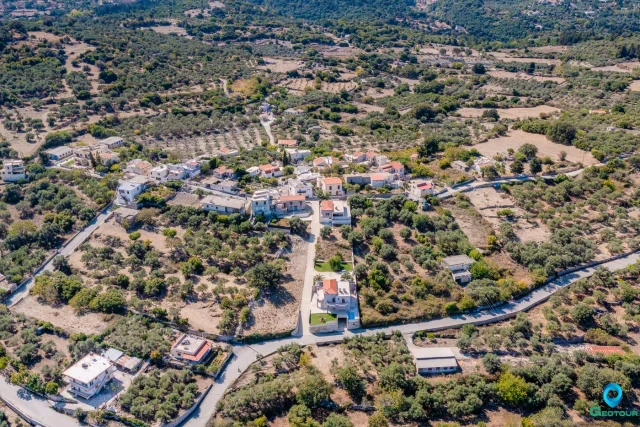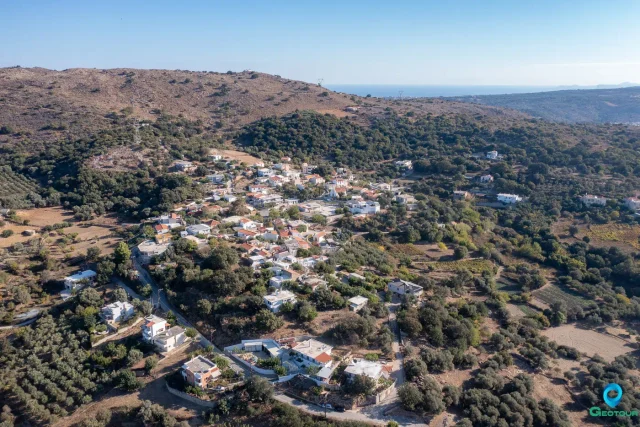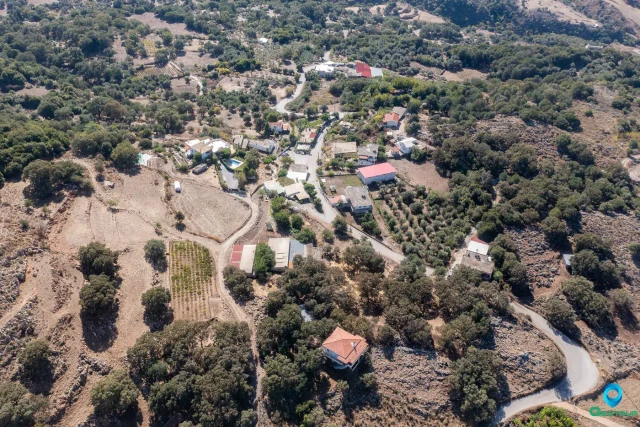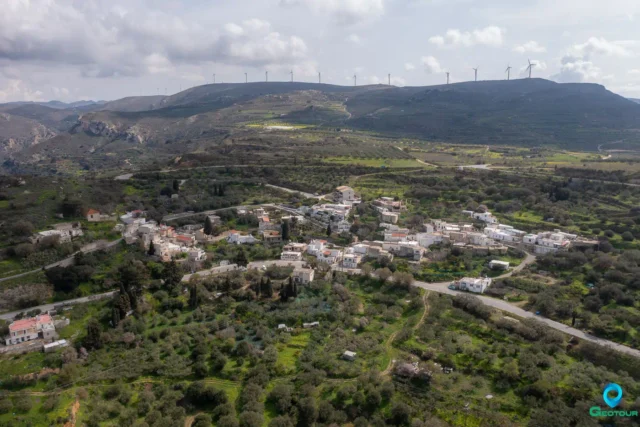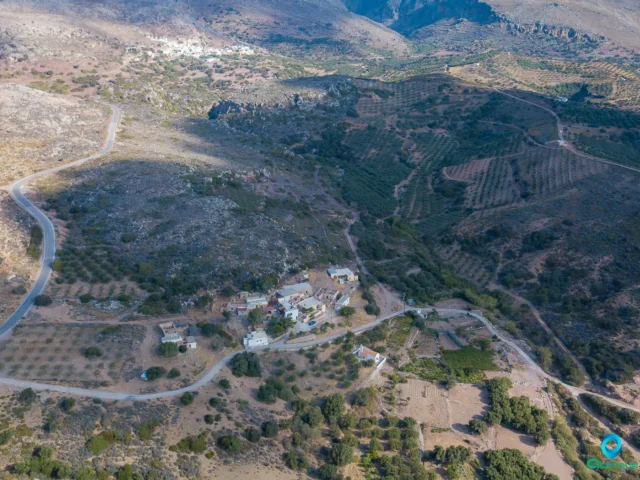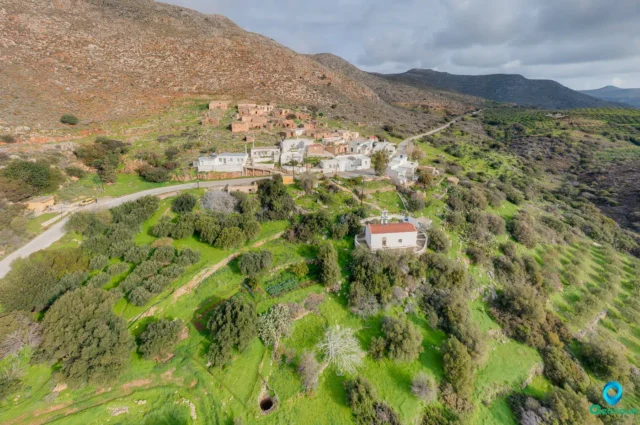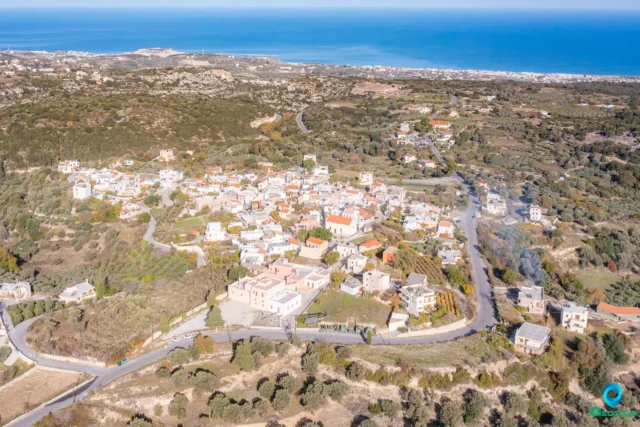438
listings found
Categories
Active filters:
Fylaki, Apokoronas
Located in Apokoronas, Chania, at 100m altitude, this is a preserved settlement with roots in antiquity, evidenced by a Late Minoan tholos tomb (1370-1200 BC). The village was mentioned in Venetian records by Barozzi (1577) and Kastrofylakas (1583). Its name is believed to derive from Ottoman-era prisons, and remnants of these buildings still stand. Key sites include the historic 1930s Primary School. The local economy is based on agriculture and livestock farming.
Agios Georgios, Rethymno
A traditional settlement in Rethymno, Crete, at an altitude of 260 meters within the Community of Agios Konstantinos. It is documented in Venetian records by Barozzi in 1577 as S. Zorzi Messoghoriti and Kastrofylakas in 1583. During the Ottoman era, some inhabitants converted to Islam following the 1770 revolution. By the 19th century, it had a mixed Christian and Turkish population. Nearby are the ruins of Artos village, which features the Church of Agios Georgios, built in 1401 with preserved frescoes.
Kato Valsamoneron, Rethymno
Located 14km from Rethymno at an altitude of 250 meters, its name derives from the aromatic balsam plant. First mentioned in 1577 by Francesco Barozzi, it was a significant Venetian military sector. During the Ottoman period, its Christian inhabitants were replaced by Turkish settlers. It was resettled by Cretan families in the early 20th century. Points of interest include the church of Agios Ioannis, with frescoes dating to the 12th-14th centuries, and the Vasile cave, site of a 1944 Pan-Cretan Resistance Conference.
Monopari, Rethymno
A semi-mountainous village in Rethymno, Crete, at an altitude of 380 meters. Its name is a corruption of "Castello Bonriparo," a fortress on a nearby hill. This fortification was central to the "Revolution of the Two Syvritoi" (1217-1236), a major uprising by the Skordilis and Melissinos families against the Venetians. The conflict ended with a treaty granting significant rights to the Cretan lords. Administratively, the settlement belongs to the community of Ano Valsamonero.
Vori, Siteia
Vori, a small village in Sitia, Crete, on the Sitia-Lithines road, is an almost deserted settlement with historical roots. Its stone houses feature unique clay pithos chimneys, characteristic of Sitia villages. The village center boasts the picturesque Michael Archangel church, while Agia Paraskevi, a Byzantine cemetery church, lies just outside. Vori's history includes Venetian rule and varying population numbers over the centuries. Despite its small size and dwindling population, Vori retains its charm, showcasing traditional architecture with stone doors and carvings, offering a glimpse into Crete's past.
Kalo Chorio, Siteia
Kalo Chorio (meaning "Good Village") is a remote village in Lasithi, Crete, located in the mountains near Sitia. First mentioned in 1881, its history likely dates back further, potentially linked to the Venetian and Turkish periods. The village has seen a significant population decline, with only 9 residents in 2011. Kalo Chorio offers a glimpse into authentic Cretan life.
Mesa Apidi, Siteia
Mesa Apidi, a village in Lasithi, Crete, near Sitia, has a history dating back to at least 1925. Not mentioned in the 1583 census, it likely developed after the 16th century. The name derives from the pear tree, though none grow there today. The village became its own community in 1928. Now part of the Apidia community within the Sitia municipality, it comprises Mesa Apidi, Goudouras, Exo Apidi, and Kalos Lakkos. The semi-mountainous terrain is used for crops and pastures. Population data shows a decline from 179 residents in 1881 to around 20 in 2021.
Agia Triada, Siteia
Agia Triada (Agia Trias), a village in Siteia, eastern Crete, has a history dating back to the Minoan era, with archaeological finds at PetroKopio, Stalos, and Alogara cave. Formerly known as Tso, its name changed in 1920. The village, not mentioned in Venetian censuses, likely repopulated in the 16th-17th centuries after pirate destruction. First recorded in the 1834 Egyptian census, it had 25 Christian families. By 1881, its population reached 158. The village's economy is based on agriculture and fishing.
Perivolakia, Siteia
Perivolakia, a small village in Sitia, Lasithi, Crete, consists of two settlements, Epano and Kato Perivolakia. Near Kato Perivolakia lies Pezoulas. The village is known for the Perivolakia or Kapsa Gorge, a 4.5km gorge with steep walls, and the nearby pre-Minoan Vournoferto cave with hunting scenes. Historically, Perivolakia is first mentioned in the 1881 census. Other sights include the deserted monastery of Panagia, caves in Kalo Nero, the Monastery of Kapsa, the old church of Agioi Saranta, beaches like Ammoudi, and the deserted settlement of Pezoulas. The village had 21 residents in 2011.
Mochlos, Siteia
Mochlos Island, a small rocky island in Crete's Gulf of Mirabello, is a significant Minoan archaeological site and a popular tourist destination. Inhabited during Minoan times, Mochlos was a major port and production center. The Minoan settlement was impacted by the Thera eruption. Later, Venetians built a fort, whose ruins remain. The island's history spans from the Bronze Age Minoan civilization through Venetian rule to its current status as a tourist attraction. The village of Mochlos faces the island.
Papagiannades, Siteia
Papagiannades, a village in Sitia, Crete, boasts a history dating back to the Minoan era, evidenced by settlement remains. First mentioned in 1834, its name derives from its settlers. The Venetian-era church of Panagia Eleousa, with frescoes from 1363-64, stands as a landmark. Known for high-quality olive oil, the village features a historic oil mill. Papagiannades offers a glimpse into traditional Cretan life, with narrow streets and hospitable residents, surrounded by olive groves. The village population, 69 in 2021, reflects its quiet charm.
Klisidi, Siteia
Klisidi, a settlement in Sitia, Lasithi, Crete, is located at 220 meters altitude. While not in Venetian or early Ottoman records, it's mentioned in a later Ottoman document and the 1834 Egyptian census with 5 Christian families. In 1881 it had 37 Christians, growing to 44 inhabitants by 1900. The population has since decreased, from 49 in 1940 to just 2 in 2021.
Kellaria, Siteia
Kellaria, a small village in the Sitia municipality of Lasithi, Crete, is situated at an altitude of 340 meters. Known for olive oil and wine production, the village's history dates back to 1583. Once an independent municipality, it later became part of Sitia. The village is divided into inhabited and abandoned sections, showcasing traditional architecture. Its population has dwindled to just four residents in 2021. The Agios Georgios church and a cemetery are located within the village. Historically, inhabitants were farmers and shepherds. Kellaria is near the Zakros archaeological site and Vai beach.
Monastiraki, Ierapetra
Monastiraki (Monastirakion) is a small village in Lasithi, Crete, situated on Mount Thrypti's slopes, near Ha Gorge, with views of Mirabello Gulf. Located 5km from Pahia Amos and 11km from Ierapetra, it's part of the Pahia Amos community. Historically, it was mentioned by Castrofylakas around 1853, possibly built on a former monastery site dedicated to Saints Constantine and Helen. The 2021 census recorded 21 residents. The village experienced population fluctuations over the years, from 10 families in 1834 to a single resident for some time, and now sees a revival with home renovations and infrastructure improvements. Points of interest include the Byzantine churches of Agios Stefanos and Agios Georgios, alongside two traditional cafes serving Cretan cuisine.
Thrypti, Ierapetra
Thrypti is a small mountain settlement in eastern Crete, within the municipality of Ierapetra, Lasithi. Nestled in the Thrypti mountains, near the Ha Gorge and Afentis Christos peak, it boasts a unique pine forest. The village has historical significance, with evidence of Minoan and Byzantine settlements. Landmarks include the churches of Nativity of Theotokos, Agios Ioannis Prodromos, Timios Stavros, and Agia Anna. The economy is based on viticulture and animal husbandry, though many residents have relocated. Access is via paved road from Pano Chorio and dirt roads from Oreino and Kavousi.
Mesi, Viannos
Mesi, a small village in the Kato Viannos municipality of Crete, Greece, is located at an altitude of 540 meters. The village's history is linked to the Ottoman-era settlement of Pera Mesi, which was tragically destroyed during a wedding celebration. Today, Mesi is sparsely populated, with residents primarily engaged in agriculture. The village has a relatively recently built church dedicated to both Prophet Elias and the Three Hierarchs.
Kalami, Viannos
Kalami, a historic village in Crete, strategically located in the semi-mountainous area of the Viannos municipality. Built during the Venetian or Ottoman period, it offered protection against raids and pirate attacks. Once a thriving community, Kalami was an important commercial center with a customs office, warehouses, and various professions. The village's economy was based on agriculture, with residents cultivating olive trees, cereals, fruit trees, and carob trees. After 1960, the focus shifted to early vegetables and bananas. Kalami also served as the main winter residence, with people moving to lower-lying "metochia" in the summer for farming. Today, Kalami is largely deserted, with most residents relocating to coastal settlements.
Selli, Rethymno
Selli (Σελί) is a village situated in the Rethymno regional unit on the island of Crete, Greece. It is located approximately 17 kilometers southeast of Rethymno town, nestled in the […]
Chromonastiri, Rethymno
Chromonastiri is a traditional Cretan village with a rich history dating back to the 12th century. It's located 11 kilometers southeast of Rethymno, near Mount Vrysinas. The village is known for its Venetian-era architecture, particularly the restored Villa Claudio, now home to the Chromonastiri Military Museum.
Chromonastiri also boasts several significant Byzantine churches, including the 11th-century Church of Panagia Kera with its unique architectural features and surviving frescoes. The Church of Agios Eftychios at Perdiki Metochi is another notable Byzantine church, featuring impressive frescoes and a distinct folk art style.
The village square houses the renovated Prinari olive mill, now an educational center showcasing the history of olive oil production and traditional Cretan life. Chromonastiri is a designated traditional settlement, offering visitors a glimpse into Crete's cultural heritage through its architecture, religious sites, and historical landmarks.
Treis Ekklisies, Archanes – Asterousia
Treis Ekklisies (Three Churches) is a small coastal settlement located 64 km south of Heraklion, in the Asterousia Mountains in Crete. The village is named after the three churches of […]



